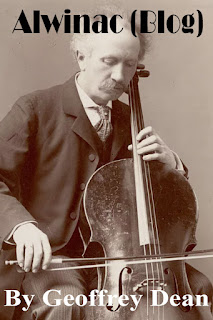 |
| [Click on image to go directly to the Alwinac’s home page] |
It has been about a year since, on a fine spring day in 2022, after the last April snow “surprise” hereabouts, I started to compose. I had little prior evidence of my own abilities as a creator of music, unless you count a number of arrangements I have done of others’ music, and in some ways perhaps these do count, but the act of writing a new piece of music requires a level of inspiration and confidence that I wasn’t convinced I had. Aside from a modest store of musical knowledge and experience, what really did I have to go on?
Twelve months and more than fifty brief pieces later, I can say that a small kernel of inspiration goes a long way. Most of the way in fact. It’s what Beethoven called the poetic idea, or what Bruce Adolphe in his wonderful new book on composing refers to as the vision stage of the creative process. It can be a mood, a rhythm, a melodic gesture, an intriguing quotation from literature, a photo or other image, a blade of grass, anything. Not necessarily anything grand or elaborate, or even all that specific. For many of the pieces I have composed (most for piano), my inspiration has come from students whose choices of musical parameters such as tempo, rhythmic motif, interval size and direction, and character have excluded other choices I might have made on my own and provided a more sharply defined and differentiated starting point for each student’s piece. As with any other type of inspiring kernel, these pre-determined aspects help guide and speed my journey down a creative path that is unique for each piece.
I have long marveled at others’ ability to thrive under what might be considered self-imposed creative constraints. My father’s very successful forays into the sestina form in poetry, where a set of pre-determined words must end each line in a pre-determined order that shifts from stanza to stanza, come immediately to mind. So do the always arresting works of Bulgarian composer Dimiter Christoff, who rarely used an interval wider than a whole-step. I too have discovered the hidden delights of such constraints, and find myself eagerly seeking them. One of my more recent solo cello compositions uses just four notes (albeit over four octaves). Others tend toward direct repetition over motivic development or transformation. One recent composition for cello and piano is limited to textures reminiscent of Beethoven, while another evokes those of Chopin, and a third those of a pop ballade. Sometimes my initial plan plays out much as expected, but with many pieces it morphs into something else along the way. I enjoy stepping back and hearing what is taking/has taken shape and how it happened, and to wonder at the very existence of something that wasn’t there before....
_______________
Read on…. [it gets better and better, says the editor]
| Copyright © 2023 by Geoffrey Dean |

No comments:
Post a Comment